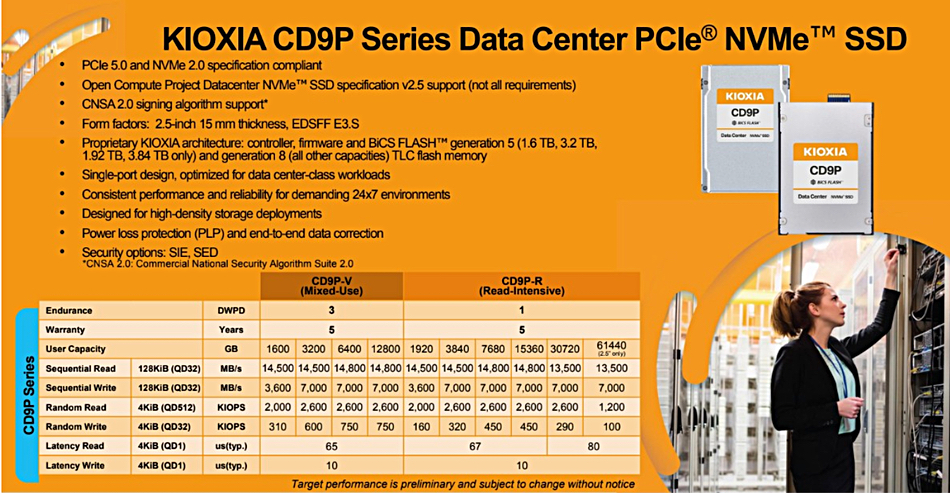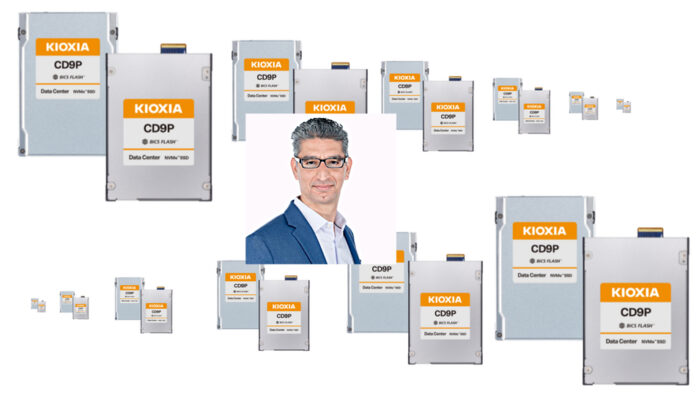Kioxia has refreshed its CD8P product line, a single-port SSD using BiCS5 112-layer 3D NAND, with the speedier CD9P line and its denser BiCS8 218-layer NAND.
Capacities of these PCIe gen 5 interconnect products have not changed much but performance has much improved. The prior CD8P products had a CUA (CMOS under Array) design while the newer CD9P has a CBA (CMOS directly Bonded to Array) technology which helps to improve performance and power efficiency.

Neville Ichhaporia, SVP and GM of the SSD business unit at KIOXIA America, stated the CD9P is “engineered for today’s most demanding AI and accelerated computing environments. By combining our CBA-based architecture with PCIe 5.0 performance, the CD9P Series helps keep GPUs consistently fed with data – significantly improving utilization while driving greater efficiency, responsiveness, and scalability across AI-driven data center workloads.”
As with the CD8P there are two versions of the drive; the CD9P-R read-intensive variant and the CD9P-V mixed-use version. Both come in two form factors: E3.S and a 2.5-inch 15mm thick alternative.
Capacities and performance vary with version and form factor, as a Kioxia slide illustrates:

The drives double the maximum capacity available per SSD compared with the previous CDP8 mixed use generation model’s 15.36 TB.
The maximum performance numbers for the CD9P drives are 2.6 million/750,000 random read/write IOPS and 14.8/7 GBps sequential read/write bandwidth.
For comparison the prior CD8P numbers are 2 million/400,000 random read/write IOPS and 12/5.5 GBps sequential read/write bandwidth.
The vendor says the CD9P Series 15.36 TB model delivers approximately 60 percent and 45 percent improvements in sequential read and write speeds per watt, respectively, compared to the previous generation SSD. It also achieves gains of approximately 55 percent and 100 percent in random read and write performance per watt, measured in thousands of IOPS (KIOPS), respectively.
We’re told the drives deliver 4-corner performance improvements of up to approximately 125 percent in random write, 30 percent in random read, 20 percent in sequential read, and 25 percent in sequential write speeds compared to the previous CD8P generation. The 4-corner concept represent four corners of a drive’s peak performance: random read and write IOPS and sequential read and write bandwidth.
The go faster still Kioxia dual-port CM9-R (read-intensive) drive, also a PCIe gen 5 and BiCS8 SSD, provides up to 3.4 million/800,000 random read/write IOPS and 14.8/11 GBps sequential read/write bandwidth.
The CD9P is faster than Micron’s dual-port 6550 ION but not as fast as Solidigm’s single-port D7-PS1010 and PS1030 SSDs.
Bootnote
The CD9P drives have a PCIe 5 NVMe 2.0 interconnect which is NVMe-MI 1.2c compliant. They have OCP Datacenter NVMe SSD spec v2.5 support (not all requirements), CNSA 2.0 signing algorithm support (prepared for the threat posed by Quantum Computers), SIE, SED, and power loss data protection (PLP) features.
KIOXIA CD9P Series SSDs are sampling to select customers and will be showcased at HPE Discover Las Vegas 2025, taking place June 23–26.








